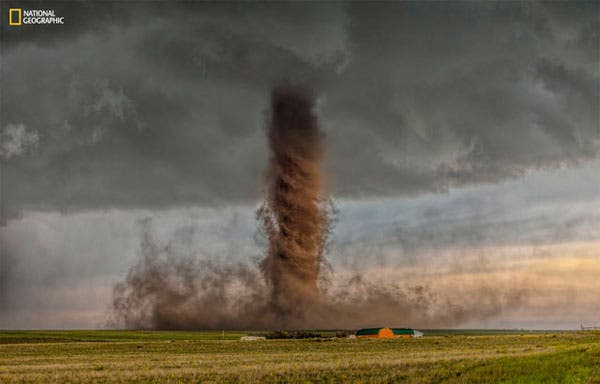The winners are in for this year’s National Geographic photo contest. After receiving over 13,000 from around the world, the judges in the most prestigiousphoto contest in the world decided that 13 deserved special recognition.
This year’s grand prize winner is photographer James Smart of Australia. The Melbourne native won $10,000 and a trip to Washington, D.C., for his photo titled “DIRT.” The photo was a culmination of the photographer spending 15 days chasing storms with his brother and friends.
Grand Prize, “Dirt,” James Smart
![]()
“Jaw-dropping, rare anti-cyclonic tornado tracks in open farm land narrowly missing a home near Simla, Colorado.” Smart spent 15 days chasing storms with his brother and some friends, and on the last day he managed to shoot the stunning shot above.
Places Winner, “Asteroid,” Francisco Mingorance
![]()
On the occasion of the preparation of a report on Ríotinto from the air, I decided to include phosphogypsum ponds located in the marshes of red and whose radioactive discharges has destroyed part of the marsh. As an environmental photojournalist had to tell this story and report it but had to do with an image that by itself attract of the viewer. I discovered this on a low-flying training that caught my attention for its resemblance to the impact of an asteroid on its green waters.
Location: Cardeñas, Andalusia, Spain
People Winner, “At the Play Ground,” Joel Nsadha
![]()
Bwengye lives in a slum called Kamwokya in Kampala, Uganda’s capital city. He cherishes his bicycle more than anything else. He brings it to this playground in the slum every evening where he watches kids playing soccer.
Location: Kampala, Central Region, Uganda
Honorable Mention, “Hill of Crosses,” Hideki Mizuta
![]()
There are many hundreds of thousands of crosses, the Hill of Crosses has represented the peaceful resistance of Lithuanian Catholicism to oppression. Standing upon a small hill is the place where many spirits of the dead lives. When I visited this place, a girl in the pink dress ran through as if she brought the peace, hope, love.
Location: Šiauliai, Siauliu Apskritis, Lithuania
Honorable Mention, “From Generation to Generation,” Jackson Hung
![]()
This photo was taken during Chinese New Year’s Eve of 2015 in Taiwan. While paying respects to our ancestors, I noticed how the light was coming into the room and saw the passing of incense sticks to each of our family members after sending our prayers. The photo is symbolic since the passing of incense sticks resembles and knowledge and wisdom passed down from generation to generation.
Location: Taiwan
Honorable Mention: “Overlooking Iraq from Iran,” Yanan Li
There are relics left along the Iran-Iraq boarders. A group of Iranian female students play around an abandoned tank. Among them, one girl stands on the tank with her arms open.
Location: Shalamcheh, Khuzestan, Iran
Honorable Mention: “Orangutan in The Rain,” Andrew Suryono
I was taking pictures of some Orangutans in Bali and then it started to rain. Just before I put my camera away, I saw this Orangutan took a taro leaf and put it on top on his head to protect himself from the rain! I immediately used my DSLR and telephoto lens to preserve this spontaneous magic moment.
Location: Denpasar, Bali, Indonesia
In Masai Mara, the cubs of the famous cheetah called Malaika became young enough to start hunting. They moved from one hill to another scanning the lands. Here, they seemed to change shifts as one cheetah leaves the hill while the other takes her place.
Location: Masai Mara, Rift Valley, Kenya
Honorable Mention: “Colorful chaos,” Bence Mate
White-fronted Bee-eaters getting together on a bough before going to sleep to their burrows, scraped into a sand wall. I was working on this theme for 18 days, as there were only 5-10 minutes a day, when the light conditions were appropriate, 90% of my trying did not succeed. I used flash lights to light only the ones sitting on the branch, and not to the others, flying above. When in the right angle, the backlight generated rainbow colouring through the wings of the flying birds.
Location: Mkuze, KwaZulu-Natal, South Africa
Honorable Mention: “Acrobat of the Air,” Alessandra Meniconzi
A flocks of Alpine choughs (Pyrrhocorax graculus), mountain-dwelling birds, performs acrobatic displays in the air. I was able, during a windy day, to immortalize their impressive flight skills.
Honorable Mention: “Nothing to Declare,” Lars Hübner
Taiwan – In the countryside, the funerals are usually accompanied by local chapels. When a family member dies, their body is kept in the house, or in a tent built specifically for this purpose. After a set period of time, the deceased, accompanied by a funeral procession is buried.
Location: Douliu, Taiwan, Taiwan
Honorable Mention: “The Game,” Simone Monte
The game (Altinho) in Ipanema – Rio de Janeiro
Location: Rio de Janeiro
Honorable Mention: “Surrealist painting in nature,” Tugo Cheng
As the largest mountain ranges in Central Asia, Tian-shan (‘sky-mountain’ in Chinese), has one of the best collections of natural landscapes in the world and is seen by many as a paradise for outdoor adventures. Thanks to the richness of sediments compounded with the power of erosion by rivers flowing down the mountains, the north face of Tian-shan is carved into stunning plateaus and colorful canyons hundreds of meters deep, resulting in this surrealist painting in nature.




